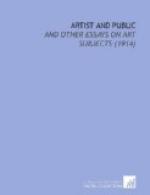his drawings and pastels to his pictures. We
have seen that he was a supremely able technician
in his pot-boiling days and that the color and handling
of his early pictures were greatly admired by so brilliant
a virtuoso as Diaz. But this “flowery manner”
would not lend itself to the expression of his new
aims and he had to invent another. He did so stumblingly
at first, and the earliest pictures of his grand style
have a certain harshness and ruggedness of surface
and heaviness of color which his critics could not
forgive any more than the Impressionists, who have
outdone that ruggedness, can forgive him his frequent
use of a warm general tone inclining to brownness.
His ideal of form and of composition he possessed
complete from the beginning; his mastery of light
and color and the handling of materials was slower
of acquirement; but he did acquire it, and in the
end he is as absolute a master of painting as of drawing.
He did not see nature in blue and violet, as Monet
has taught us to see it, and little felicities and
facilities of rendering, and anything approaching
cleverness or the parade of virtuosity he hated; but
he knew just what could be done with thick or thin
painting, with opaque or transparent pigment, and he
could make his few and simple colors say anything
he chose. In his mature work there is a profound
knowledge of the means to be employed and a great economy
in their use, and there is no approach to indiscriminate
or meaningless loading. “Things are where
they are for a purpose,” and if the surface
of a picture is rough in any place it is because just
that degree of roughness was necessary to attain the
desired effect. He could make mere paint express
light as few artists have been able to do—“The
Shepherdess” is flooded with it—and
he could do this without any sacrifice of the sense
of substance in the things on which the light falls.
If some of his canvases are brown it is because brown
seemed to him the appropriate note to express what
he had to say; “The Gleaners” glows with
almost the richness of a Giorgione, and other pictures
are honey-toned or cool and silvery or splendidly
brilliant. And in whatever key he painted, the
harmony of his tones and colors is as large, as simple,
and as perfect as the harmony of his lines and masses.
[Illustration: Plate 9.—Millet.
“The Shepherdess.” In the Chauchard
collection, Louvre.]
But if we cannot admit that Millet’s drawings
are better than his paintings, we may be very glad
he did them. His great epic of the soil must
have lacked many episodes, perhaps whole books and
cantos, if it had been written only in the slower
and more elaborate method. The comparative slightness
and rapidity of execution of his drawings and pastels
enabled him to register many inventions and observations
that we must otherwise have missed, and many of these
are of the highest value. His long training in
seizing the essential in anything he saw enabled him,
often, to put more meaning into a single rapid line




